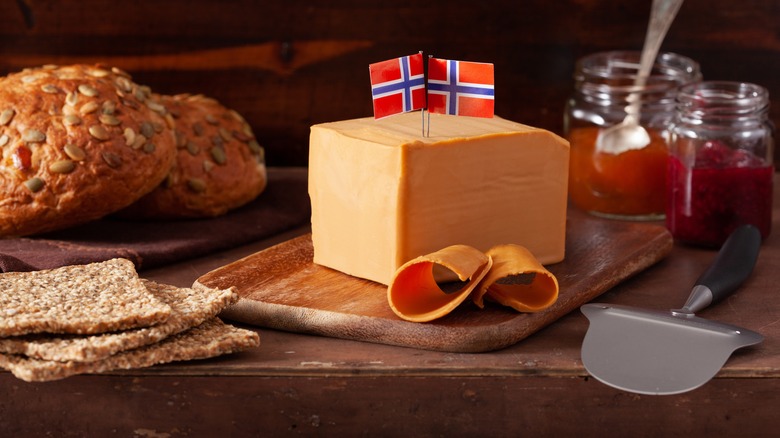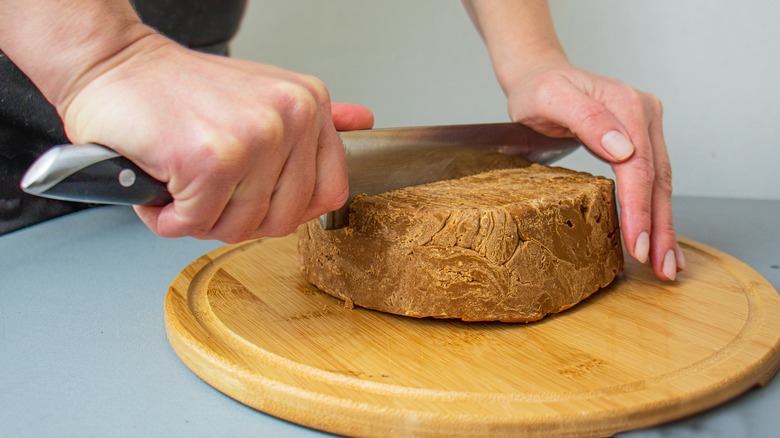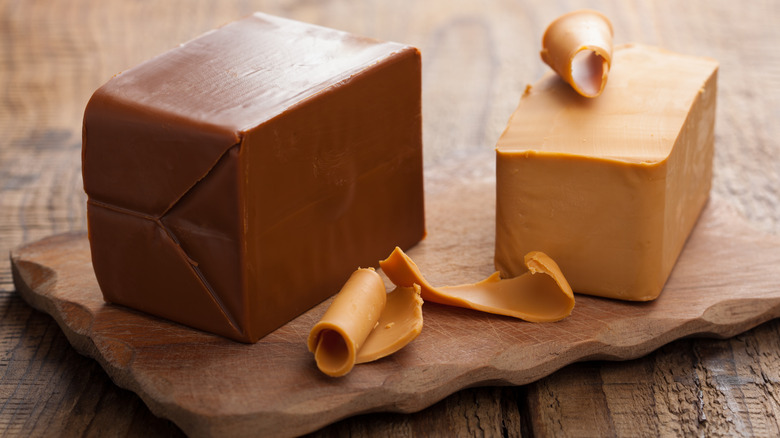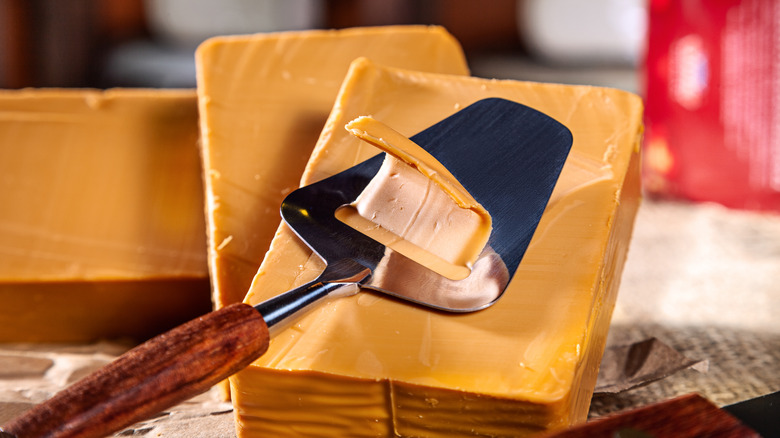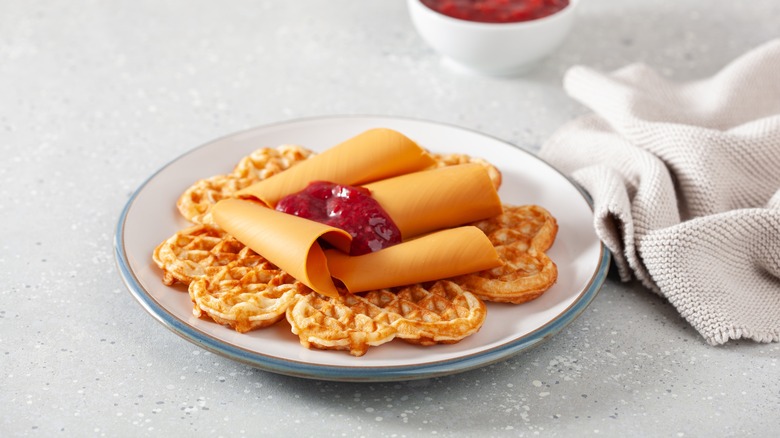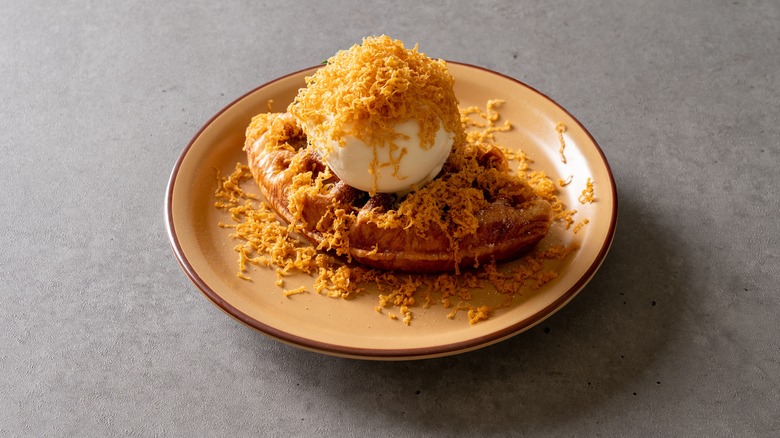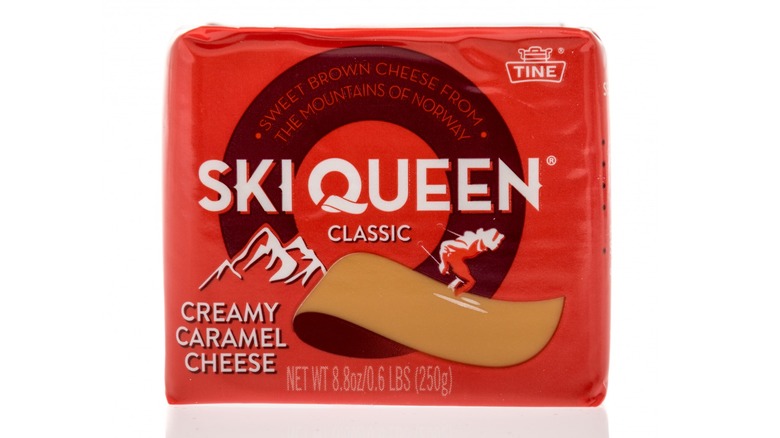What Is Brunost Cheese And How Do You Eat It?
Brunost doesn't look like any other cheese you've seen. It doesn't feel like any other cheese you've eaten. And it certainly doesn't taste like any other cheese you've tasted. In fact, some argue that it isn't even cheese at all.
A staple of Norwegian cuisine, brunost literally translates to English as "brown cheese," and is named for its caramel hue. It comes in bricks so smooth that you'd think they were made out of clay, and it is so dense and sticky that it can only be sliced with a cheese plane. The contentious debate over Brunost's flavor, delightful to some and off-putting to others, has earned it comparisons to other polarizing national favorites like Vegemite and Marmite.
Now here's the twist: brunost is not actually cheese, at least, not according to most definitions. Mirriam-Webster defines cheese as "a food consisting of the coagulated, compressed, and usually ripened curd of milk separated from the whey," but this does not apply to brunost, which is actually a byproduct of making other types of cheese. Rarely found outside of its homeland for decades, brunost is beginning to find an international fan base, and it's probably available at a grocery store near you.
How is brunost made?
What sets brunost apart from other cheeses, and the reason it's not technically even cheese, is all in the manufacturing process. While cheese is made from milk curds that have been separated from the whey, brunost is made with the leftover whey that was separated from the curds. It's the ultimate example of "waste-not, want-not," ensuring not a single drop of milk goes to waste.
To make brunost, leftover whey is placed in a pot with cream, milk, or a combination of both. The mixture gets boiled down until the water evaporates and the sugars in the whey caramelize and turn golden. This process is an example of the Maillard reaction, which is also behind the browning of toast, seared steaks, and the time-consuming process of caramelizing onions. The longer the whey mixture cooks, the darker it becomes, and finished blocks of brunost range from light golden caramel to dark chestnut brown. Brunost is not aged, like many other cheeses are, and it only lasts for a couple of months in the refrigerator.
Varieties of brunost
Brunost is technically a category of cheeses, all made via the same unique process. The difference between each variety mainly has to do with the type of milk used to make it, which could be cow's milk, goat's milk, or a combination of the two.
According to Norwegian dairy product supplier TINE, the most common variety of brunost is called Gudbrandsdalsost or Gudbrandsdal cheese and is made using a combination of cow's milk and goat's milk. This variety is Named for the valley of Gudbrandsdalen, where a farmer named Anne Solbrå Hov is said to have invented modern brunost in 1863. Caramelized whey has been a part of Nordic diets since the Bronze Age, according to Science Nordic, but Hov is credited with being the first to add cream to leftover whey, making the creamy brunost that is so popular today.
In addition to Gudbrandsdalsost, there are two other types of brunost: fløtemysost, which is made only from cow's milk, and geitost, which is made only from goat's milk.
What does brunost taste like?
Brunost has a unique, sweet-and-savory flavor profile dominated by its caramelized sugar content. Many people liken its taste to that of the popular Latin American confection, dulce de leche. However, brunost also has salty and tangy aspects that set it apart. The flavor varies from one type of brunost to the next, with the all-cow's-milk fløtemysost having the mildest flavor, and the all-goat's-milk geitost having a distinct acidic tang to it. The production process also has a significant impact on flavor, particularly the ratios of milk, cream, and whey used by the manufacturer, and the cooking time. The darker the brunost, the more intense its flavor will be.
Flavor isn't the only thing setting brunost apart from other cheeses, as its texture is equally worthy of note. Brunost is dense and creamy like fudge, and it tends to stick to the roof of your mouth when you eat it, just for a second, before melting. This cheese has an exceptionally low melting point to go with a high-fat content, which makes it creamier than most other cheeses.
How to serve brunost
Brunost's dense and sticky texture can present a challenge when serving it, and this actually led Norwegian cheese fanatic Thor Bjørklund to invent the modern cheese plane in 1925. That's right, the iconic handled cheese slicer (with its rounded triangle shape and raised sharp edge), now used around the world was originally invented for brunost! In Norwegian, it is called an "ostehøvel," and it produces neat, curly cheese ribbons when dragged across a block of brunost. In traditional Norwegian fashion, these slices are served with sliced bread or, occasionally, waffles. It is often eaten plain, but may also be paired with jam for a sweet-and-savory blend.
Atlas Obscura explains that curiously, the country where brunost is most popular outside of Norway is the typically cheese-averse South Korea, where it is served in a few unique ways. The most unexpected, perhaps, is the use of finely shredded brunost as an ice cream topping, somewhat reminiscent of salted caramel. There is also a popular Korean treat called a croiffle, which is a waffle made from croissant dough. Shredded brunost is a common topping for croiffles as well as South Korean pizza.
How brunost became a South Korean sensation
It is rather curious that a regional cheese variety barely known outside of Norway should become a massive hit half a world away in South Korea, but it did, and it's all thanks to one woman. Jeonmi Eom discovered brunost when her husband brought some back from a business trip to Norway. She fell in love with its unique taste and texture, and thought it would be perfect for the South Korean market, given that sweet-and-savory food combinations are extremely popular there. Suffice to say, she was right.
Eom got in touch with Synnøve Finden, one of Norway's leading brunost producers, and she secured an exclusive license to market their product in South Korea. With their backing, she opened a chain of Synnøve cafes in Busan. She figured that the Norwegian method of eating brunost — in big, thick slices — might be overwhelming for Korean diners experiencing it for the first time, so she pioneered the use of fine graters to turn brunost into a versatile topping. Now, many cafes throughout the country offer items topped with shavings of brunost.
Where can you get brunost?
Given that it's a regional specialty, there aren't that many companies that make brunost for wide distribution. Synnøve Finden is one of the leading brands, named after its iconic founder. According to the brand's website, Finden and her friend Pernille Holmen started their cheese business in 1928, becoming Norway's first female factory owners. Jeonmi Eom considers Finden's story to be a crucial part of brunost's popularity in South Korea — a company mascot that represents true ambition and success. Today, Synnøve makes two types of brunost: Gudbrandsdalsost and fløtemysost. You probably won't find them in U.S. stores, but you can order their cheese online through retailers like Norwegian Foodstore.
The only brand of brunost widely distributed in the United States also happens to be Norway's largest dairy producer: TINE. They use an alternative brand name for the American Market: Ski Queen. It is available in many supermarkets and comes in two varieties. The first, Ski Queen Classic, is a traditional Gudbrandsdalsost cheese with a creamy texture and slight tanginess. The second variety, Ski Queen Goat, is in the geitost style, using only goat's milk for a saltier, tangier product. Both are worth a try; just be sure to have your ostehøvel at the ready.
